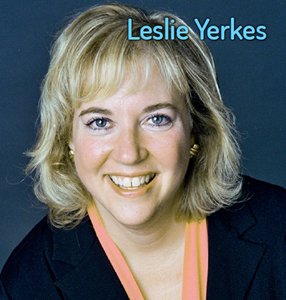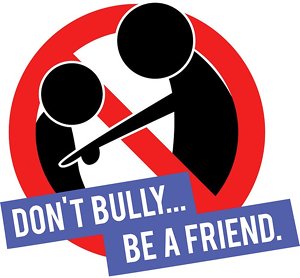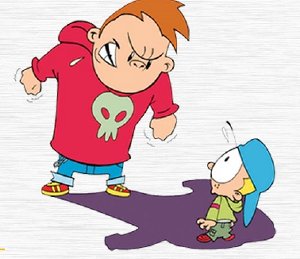 Guest post by Leslie Yerkes.
Guest post by Leslie Yerkes.
One of the ways in which people try to effect change is through bullying. The act of bullying can be physical, emotional, psychological, or sexual. There are three aspects of bullying: being the bully, being bullied, or stopping bullying when you see it.
Bullying may be common and a common part of living but it is never good. Bullying hurts people — physically, emotionally, socially, and spiritually. Bullying may even scar for life.
Bullying has existed for as long as there have been children asserting their power over other children — which is, unfortunately, forever. When as adults we tangle, our inability to persuade through reason may lead to this heavy-handed and righteous assertion of power.
In spite of what the collective human experience has learned about behavior and our advance toward tolerance, the stresses of living and working with others often erode our best intentions and drive us back to our most primal method of interaction — the use of force to get our way.
Though we may have reduced the level of autocratic leadership in the workplace, bullying has sprouted in other forms of adult interactions such that it seems as if there is an epidemic of bullying. Currently, I’m witnessing a lot of bullying. For one of the few times in my life, I am feeling the effects of being bullied by a team of bullies.
My history of bullying
In my professional life as a consultant, dealing with the aspects of workplace bullying is an ever-increasing function of my work. To be effective in those situations, my experiences tell me which steps to take, and when to take them. I know what to say and with whom to say it. I am supremely confident in my ability to deal with all aspects and forms of bullying. The hierarchy of business contains built-in structures which, when properly accessed with the right behavioral tools, help guide people toward appropriate behavior.
 In my personal life, however, I find I’m challenged to use those same tools. Professionally, I’m able to bring folks to the table and get them to talk. Personally, I find myself less able to achieve the same results — those who bully are largely reluctant to want to talk. They like the power that bullying gives them and I have no way to get them to discuss the situation. Professionally, I’m a mediator, an intervener. In my personal life, I find myself waiting for someone to intervene on my behalf.
In my personal life, however, I find I’m challenged to use those same tools. Professionally, I’m able to bring folks to the table and get them to talk. Personally, I find myself less able to achieve the same results — those who bully are largely reluctant to want to talk. They like the power that bullying gives them and I have no way to get them to discuss the situation. Professionally, I’m a mediator, an intervener. In my personal life, I find myself waiting for someone to intervene on my behalf.
In my case, the hostile environment being created by the bullies in my condominium association extends to all the people within this community. Though the other tenants may totally disagree with the bullies, and support my situation, they are fearful that if they stand up to be counted, they, too, will be bullied. So, I am alone, bullied, and unable to come to my own rescue. When it comes to being bullied, I’m not intervening very effectively on my own behalf.
 There are two outcomes to my current bullying experience.
There are two outcomes to my current bullying experience.
First, experiencing this level of personal torment, I have reached a better understanding of what bullied employees in my professional life are undergoing. While I am an astute and accurate observer of life, people, and interactions, I now realize I was missing an important component to bullying — what it actually feels like to be bullied. The understanding that the negative aspects of bullying stay with you all day and all night. The feelings are always there. Your mind is consumed by the pain, confusion, fear, and anguish. Bullying’s results never sleep. Nor do they allow you to.
Second, being unable to apply my professional anti-bullying toolkit to my personal life, I have come to the understanding that there are three choices the bullied have — continue to be bullied, bully back, or change. The paradigm for change hinges on this concept: “If you can’t change the situation, change yourself.”
Deciding to change yourself
When I realized I had little or no power over my bullies and that bullying back (though, admittedly one of the first reactions one has) only escalates into more attacks, I chose to change myself.
The best decision I made was to choose not to stand alone. In my case, I found a great and sympathetic attorney who advised me NOT to fight the injustices but to deal with the legal details that would derail the bullies’ engine of power. He also advised me to stop telling the story of being bullied because the repetition of the details drains my energy and negatively impacts my attitude.
 I also committed to maintaining myself as the person I want to be. That is, I decided not to allow my bullies to change me. In the process, I realized that while I should model zero tolerance for bullying and that I should not bully back, what I really needed was specific, clearly defined things-to-do to help me deal with the negative effects of being bullied.
I also committed to maintaining myself as the person I want to be. That is, I decided not to allow my bullies to change me. In the process, I realized that while I should model zero tolerance for bullying and that I should not bully back, what I really needed was specific, clearly defined things-to-do to help me deal with the negative effects of being bullied.
Surprisingly, what I found when I looked was infinite space.
In “Man’s Search for Meaning,” Victor Frankel said there is a space between stimulus and response. Space, by definition, is infinite. And infinite space contains an infinite number of possibilities. That meant that as I searched for a response to being bullied, what I needed to do was use my awareness and self-control to search the space to find and follow a response  that best reflects the person I choose to be. A response that would not allow me to resort to the easy, automatic reactions — the use of force or hiding from the world.
that best reflects the person I choose to be. A response that would not allow me to resort to the easy, automatic reactions — the use of force or hiding from the world.
When bullies are attacked, they will try to defend their behavior and attack those trying to prevent that behavior. They will accuse you, call you names to your face and behind your back, and try to undercut you and your authority in every way possible. To defend against that, we role model, praise their good behavior, and set boundaries of what is permissible and what is not. And we are prepared to be verbally abused.
As a result of my search into how to best deal with bullying, I decided always to hold my head up. I do not back away from my bullies when I see them down the hall. Surprisingly, when the bullies see me in the lobby, they are the ones who turn and run, hiding from confronting me directly. I remain strong, they cower in fear. And I did nothing to them to create that fear except choose NOT to hide.

Watch out! Don’t be one
In all ways, the response we choose to being bullied, the response that best reflects our authentic self, will represent the vision of who we are and who we choose to become. Our chosen response, then, will encourage us to ignore negative voices — the bullying — and choose a bright and ennobling path to follow.
In this world of social media, anonymity allows many to feel powerful and free to say whatever they wish. That anonymity engenders hateful and anti-social speech with little or no fear of consequence or reprisals. The danger to you and me is that because people tend to copy the behaviors and language of the people with whom they associate, we run the risk of falling prey to bullying anyone into doing something we think they ought to do.
Fortunately, there are five touchstones that will keep us from becoming the bully we never thought we’d be.
1. Bullies don’t take responsibility, they place blame. When we find ourselves in a blaming mode, shift toward ownership. Recognize that things might be at least partly our fault, take ownership of our part, and accept the responsibility to make change.

2. Bullies use force, resist force, and do not practice humility. When we find ourselves pushing to get people to agree with us or follow what we think is a really great idea, we should step back. Shift from righteous to engaging. Realize that our previous efforts have produced results that were the opposite of our intentions. Be humble. Choose a response that is the opposite of force. Create a mantra, a word or a phrase, that will remind you to shift from choosing force to choosing to let go.
3. Bullies tell people what to do, they never ask. When we find ourselves giving lectures and providing step-by-step instructions that seem to have the force of God behind them, we might be better served by asking questions. Consciously begin with open-ended questions that are blameless, earnest requests for information. That will begin the process of improving communications and move us off the path of bullying.
4. Bullies are never wrong and are not open to change. When we find ourselves consistently believing no one else knows the right things to do or the correct way to behave, we are firmly in the grip of judging. Shift to supporting, listen without bias, and suspend judgment. We often find that the right way is now free to blossom on its own.

5. Bullies don’t believe we are capable. They are certain everything we do is doomed to failure. When we abandon doubt and negative language and replace them with the power of positive expectation, we discover that people will succeed. When we believe they can, they will.
Being bullied has forced me to take stock of myself and those around me. As a result, I am becoming a better consultant and a better person. Since I was unable to change the situation, I chose to change myself. And I am better for my choice.
- How do you feel about bullying?
- Do you see it around you?
- Do you see it in yourself?
- To what extent are you willing to go to prevent bullying in the workplace, in your family, and in your personal life?
- When you are bullied, how do you respond?
- Did you adequately search the space between stimulus and response?
- Did your response accurately represent the person you truly are?
By exhibiting your true, honest, and authentic self can you foresee the possibility of having a positive effect on the bullies in your life?
Leslie Yerkes
Leslie Yerkes has been advancing the cause of positive organizational culture for over twenty-five years, ever since she started The Catalyst Consulting Group with a mission to do “consulting with a conscience.”
Leslie is the author of six books.


This Post Has 6 Comments
Donald Trump in the USA presidential election resembles your description of a bully!!
Now that you mention it… A sad role model of outdated leadership in my opinion. I hope that nuance, tolerance, and openness to diversity will soon be modeled again in the public domain as well as in our workplaces, communities, and homes.
Best write up on resisting work place bullying. However institutional bully is very daunting and will see civility as weeakness and before you realise it …. everyone is waling on your back. When bullying starts at the top, it’s hard to deal with as every subordinate embraces bullying just to be in the good book of the boss. This will involve having team members who will become docoys and undercover against the bullied – and of course reporting upwards to create more strategies in the entire team to take out the bullied in every way possible. At a same grade level, this strategy may work, but if it’s cultural it may be an uphill task. Most bullies device bullying as a strategic means of covering up their inadequacies and poor self confidence. It has to be dealt with from above, BULLYING costs so much; financially, skill-wise and resources beyond imagination to organisations who condone and permit it.
Yes, Natachi, it may be a daunting, uphill task and it requires courage to change your response. It will take time and effort, and there’s no guarantee that you’ll be successful. Yet, I believe that changing yourself to role-model kinder ways of being and behaving radiates enormous moral power and will make (some) others think. It may invite others to change, too. While support from the top is essential to change a complete organizational culture, every change requires personal change and courage – just like Leslie Yerkes describes. If that is not enough (which might be the case in really toxic places) your best response may be to leave this workplace for your own safety. If more people do so, this will send a signal that something is wrong.
As in physical attack, if your attacker is bigger or stronger, try to allow them to hit the wall using their own strength. Deflect their attack so that they receive the force they were intending for you. I know that sounds too simple, but you can be creative with the tactic to secure this.
We allow ourselves to being bullied. We create our own upsets by our perception of the bully’s behavior. We can choose not to by ignoring it, and not make it mean anything.
When bullies realize it has no effect on us, it does’t work, they let go, as they have no power or control over us. 🙂 Thor